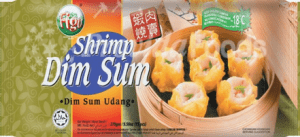ShaoMai (烧卖)
ShaoMai (烧卖) was originally from Huhhot, Inner Mongolia. It was known as the northern type of ShaoMai which usually filled with chopped or minced mutton, scallion and ginger, then wrapped by a thin and round sheet of unleavened dough. The filling is put to the middle, and wrapped into a flower petal shape. It can be either steamed or pan-frying. People served the Hohhot ShaoMai in the unit of “liang”(量). The Hohhot ShaoMai is commonly served with vinegar and tea.
As the shaomai started to spread to other places such as Shanghai, Guangdong. People modified or changed the filling and the wrapping method from the originated one. For example, the shaomai in Shanghai is filled with glutinous rice with a mixture of pork and mushroom, to give the shaomai extra chewiness.
However, the shaomai that we commonly see today, is the Cantonese-style shaomai, which was also pronounced as “Siumai”. The Cantonese-style shaomai was originated from Guangdong province. It is a small-bite sized dish, filled with either minced pork or chopped shrimp, Chinese black mushroom, scallion, and ginger with seasonings of Chinese rice wine, soy sauce, sesame oil and chicken stock. It is wrapped by a thin sheet of lye water dough, which is usually yellow in colour. And, the center of the siumai will be garnished with an orange dot, which made of crab roe or diced carrot.
Dim sum (点心)
Does the shaomai same as Dim Sum?
No, the shaomai is actually one of the dim sum dish. Dim sum is a Cantonese cuisine that served the small bite-sized portion of food in a small steamer baskets or a small plate. The dim sum usually goes along with the yum-cha practice. And, the Cantonese will treat this as their breakfast or tea brunch.
Usually, the waiters will push a cart of dim sum around the restaurant, and the customers can choose from there. There is a wide variety of dishes such as buns (包子), dumplings (饺子), cakes (糕), rolls (卷), porridges (粥), etc. And, different regions, serve the dishes in different ways.
Yam-cha (饮茶)
It means drinking tea in Chinese. It was being introduced to Hong Kong during the post-war era. During that time, the traders went for yum cha to socialize. And, the tea house was allowed to bring their pet which is the bird. So the customers would chat among themselves about the bird.
However, the culture of bringing the pet bird to the tea house was prohibited later.
The yum-cha practice was changed from being a venue for people to socialize into a social gathering venue. And, most of the tea house was changed into a restaurant which was bigger in size. The restaurant can provide formal meals for weddings and birthday purposes and some of them can provide entertainment as well.
Besides, the changes in yum-cha practices showed the structural changes in hong kong society. The food served in the restaurant is street food that previously known as lower cuisine. However, as the growth of the economy, the more and lower working class are transformed into middle-class status.
Modernization of the Chinese Food (Shaomai)
Due to the advancement in food technology, the shaomai was made as frozen food. Thus, the frozen shaomai can be introduced to more places and countries.
The Halal version of shaomai. It’s Chinese food but had managed to get the Halal-certification.
And the shaomai today are even modernized into different types of fillings such as the black pepper chicken, crab filling and even the curried fish meat.
References:
Baker, H. (1989). The Food of China. By E. N. Anderson. [New Haven and London: Yale University Press, 1988. 263 pp. £14.95.[. The China Quarterly, 119, pp.661-662.
Liu, J. (2011). Chinese food. Cambridge, UK: Cambridge University Press.
Wu, D. and Tan, C. (2001). Changing Chinese foodways in Asia. Hong Kong: Chinese United Nation Press.












